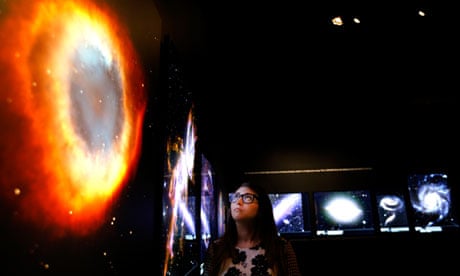A child has just stepped onto the Red Planet. While visitors to Visions of the Universe, an exhibition of astronomical photography that has just opened at the National Maritime Museum, gaze at hyper-lucid images of the rings of Saturn and moons of Jupiter, she stands in front of a panoramic projection of images from Mars that are so vast, so detailed, that to stand here feels like a real-life visit to the empty desert of this alien landscape.
Mount Sharp looms ahead, photographed by the Curiosity rover in 2012. Its orange strata lie exposed layer on layer beneath the pale Martian sky. Rocks in the foreground look solid enough to touch.
I drag myself away beyond the solar system to the very edge of the universe, to gaze on tiny shining cigar-shaped galaxies photographed by the Hubble space telescope at the very limit of human knowledge.
By the time they reach this image of the Hubble Ultra-Deep Field, one of the last glories in this enrapturing show, many visitors will feel, as I did, ecstatic and overwhelmed – not just by the beauty of the cosmos but the scales of time and space this exhibition encompasses. To put it bluntly, this is the most beautiful and significant exhibition I have seen in ages. It is a great moment, when a revolution in science and art explodes into the public eye like the proverbial champagne supernova in the sky.
The quality of photographs taken by the Hubble orbiting telescope, robot space explorers like Cassini and Galileo and most recently Curiosity has transfigured our perceptions of space. Tiny dots in the night sky are now known to be just a hint of astral magnificence. Beyond the naked eye rise stupendous veils of luminous smoke in a space that is not empty, but teeming with energy like a Turner painting.
It is one thing to look at these pictures in a book or on the Nasa website, but this exhibition shows them at the scale they deserve, in a brilliantly generous display that reveals the full daunting wonder of these eerily gorgeous pictures from beyond our atmosphere.
There are even some dazzling pictures taken by amateur astronomers, one of whom happens to be the Turner prize-winning artist Wolfgang Tillmanns. His photographs of Venus in transit across the pink disc of a filtered sun raise a question: is it art? This show proves astronomy is generating some of the most visually beguiling images of our time, but is their beauty that of art or science?
When the Hubble telescope photographed the Pillars of Creation, immense columns of star-forming dust in the Eagle nebula, the resulting image was given colours that symbolise different key elements identified in it. Ever since, photographs from space have been cherished, and processed, as aesthetic objects as well as factual records. Yet the colours and atmosphere enrich scientific knowledge. Among other things we sense the sheer sublime scale of phenomena that are light years across, and millions of light years away.
Science or art? The question fades before the power of a reality that dwarfs us. This exhibition proves that Keats was right. Beauty is truth.
Visions of the Universe is at the National Maritime Museum, Greenwich, until 15 September.
